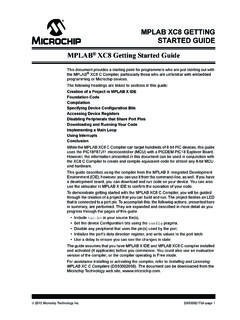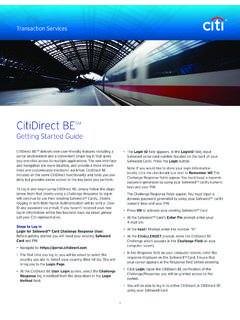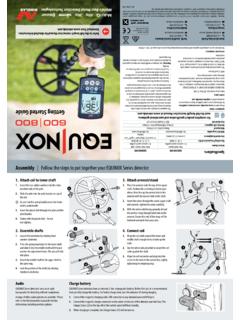Transcription of Getting Started with CalculiX - Download bConverged
1 Getting Started with CalculiX Jeff Baylor Convergent Mechanical Solutions LLC CGX Tutorial based on a tutorial by Guido Dhondt Additional contributions by Chris Fisichella Contents Contents .. 1 Testing the Installation Using the Command Line .. 2 Tutorial Conventions .. 5 CalculiX GraphiX (CGX) - Preprocessor Tutorial .. 5 Solve with CCX and Post-process with CGX - Tutorial .. 18 Getting More Help .. 24 2 Testing the Installation Using the Command Line On Windows, click on the CalculiX Command short cut in your Start Menu [Start] [Programs] [ bConverged ][ CalculiX ] [ CalculiX Command] On UNIX/Linux, open a shell. At the command prompt type: cgx -b Does the CalculiX Command window appear? The window should have usage information displayed.
2 There may be a warning message stating that the file does not exist. This is ok. If the file does not exist, CGX will create it when you save the file for the first time. Close the CGX window by clicking the close box. If you prefer working at the command line, copy one of the CCX tests and view it in CGX by typing these commands (on Windows): copy %CALCULIX_ROOT%\ CalculiX \ccx\test\ . cgx -c Does the CGX window appear with a beam rendered? Quit the CGX window. As an alternative to the command line, copy the same file from the installation folder to your working folder using Window Explorer. In Windows Explorer, double click on the file to open it in CGX. Does the CGX window appear with a beam rendered? Quit the CGX window. 3 In Windows Explorer, right mouse click on the file and select the Edit option.
3 This will open the file in a customized build of the text editor SciTE. Scroll to the bottom of the file and add the following lines just before the *END STEP line: *NODE FILE U *EL FILE S,E These request the solver to write deformation, stress and strain data to the results file. Save the file using <ctrl>s or the menu option [File][Save] Solve the model with CCX by pressing the keys <ctrl>F10 or use the menu option [Tools][Solve]. Alternatively, to run the CCX job from the CalculiX Command prompt, type: ccx beampl Is "Job finished" the last line printed? To view the results, open them in CGX. From within the text editor, press the keys <shift>F10 or use the menu option [Tools][Post process]. To run CGX from the CalculiX Command prompt type: cgx -v Does the CGX window appear with the same beam rendered?
4 Hold the left mouse button down in the left margin and select from the menu: [Data Sets] [-Entity-] [4 All] Does a contour plot render? 4 If all of these operations succeed, then the core components of CalculiX are installed properly. To test the solver in depth, run the test suite from your Start Menu. [Start] [Programs] [ bConverged ][ CalculiX ] [Test CalculiX ] This may take several minutes. 5 Tutorial Conventions K: keyboard command LMP: press left mouse button LMR: release left mouse button LMPR: press and release the left mouse button MM: press middle mouse button RM: press right mouse button M: move mouse (no pressing or releasing) V: visible result E: press enter Comment CalculiX GraphiX (CGX) - Preprocessor Tutorial This tutorial is based on a tutorial written by Guido Dhondt which is available at In UNIX/Linux, start the tutorial by opening a shell.
5 In Windows, either open the CalculiX Command window [Start] [Programs] [ CalculiX ] [ CalculiX Command] or start the Launcher [Start] [Programs] [ CalculiX ] [Extended Version][ CalculiX Launcher] K: If using a command line, start cgx by typing "cgx -b " (without the ""), press enter (E). If using the Launcher, open a new file named " " with CGX. The -b flag is the default flag when the Launcher opens an FBD file. V: A drawing window is created with on top " CalculiX GraphiX No. 1" for Linux or " CalculiX GraphiX" for Windows, on the bottom " ", a drawing area within which there is a coordinate system x-y-z and a mouse pointer. The -b indicates build mode. The file " " will be opened if it exists, otherwise a new file will be created. M: Move mouse into newly created window K: Type "pnt p1 0 0 0", E Keyboard commands are accepted only if the CalculiX GraphiX window is active 6 V: The text "pnt p1 0 0 0" appears in the window you Started cgx in.
6 M: V: A blue dot appears in the drawing window K: Type "pnt p2 1 0 0", E M: Move mouse in the drawing window to the left of the drawing area or below the drawing area (this area is also called the menu area) LMP V: A grey menu appears, on top "Viewing", on the bottom "-QUIT-". M: Move the mouse down to the item "Frame" LMR V: Two blue dots representing the points appear in the drawing area. K: Type "plot pa all", E V: Blue labels p1" and "p2" appear next to the blue points K: Type "plot pa all r", E V: The dots and labels are red now. g=green, y=yellow, k=black, b=blue m=magenta If you mistype the first letter of a command, press enter, and type the command again; else, if you mistype any other letter, move back with the back key and retype the wrong letters K: Type "qlin", E M: Move the mouse inside the drawing area K: Type "r" M: Move the mouse pointer a little bit to the right and down K: Type "r" M: Move the mouse a bit V: The mouse pointer changes into a rectangular pointer, the size of which is determined by the positions at which you typed the r's: the first "r" denoted the upper left corner, the second "r" the 7 lower right corner Notice that for some commands, no enter (E) is needed after typing the command.
7 This is, for instance, the case for "r" above M: Move the new mouse pointer onto the dot symbolizing p1 K: Press "b" (for begin) V: The marked point s definition will be printed to the typing window, unless you missed it. M: Move the pointer onto the dot symbolizing p2 K: Press "g" (for generate) V: The marked point s definition will be printed to the typing window as well as a description of the line you created To create a circle, mark the first point with "b", then the center point with "c" and finally the end point with "g" K: Type "q" (to exit the qlin command) V: The text "done" appears in the typing window M V: The mouse pointer returns to its original form If you do not quit, you can continue to draw lines using repeatedly "g" to create connected line segments, or interrupting with "b" to start a line from a new starting point.
8 with "l" an existing line can be picked and redefined using "b", "c" and "g" K: Type "plus la all" E V: The newly created line appears together with its label. If you type "plus l all" E, no label appears If you type "plot l all" the drawing starts from scratch and only the line appears (the points and point labels disappear) K: Type "qadd se1", E K: Type "a" V: After a fraction of a second the text "mode:a" appears in the typing window. Always wait for this text before proceeding. Now create a window encompassing the line M: Move the mouse pointer to the left upper corner of an imaginary rectangle 8 encompassing the line T: Type "r" M: Move the mouse pointer to the right lower corner of an imaginary rectangle encompassing the line T: Type "r" M V: A rectangle appears with the size you just defined If nothing happens, LMPR in the menu area and returning the mouse into the drawing area usually helps M: move the rectangle such that the line is inside it If the rectangle proves to be too small, restart the marking of the corners with "r" K: Type "l" (for lines) V: In the text window the lines "caught" by your rectangle are listed (here only L1).
9 In the drawing area the line is shown pink K: Type "q" (to quit the qadd command) By the previous command you created a set with name "se1" and containing one line with name "L1" Notice that the line name was given automatically. Names provided by the program always use CAPITAL letters 9 K: Type "plot la se1", E V: The lines and their labels contained in set se1 appear in the drawing area, in this case just one line K: Type "plot la all", E V: Nothing really changes The set "all" contains everything and always exists K: Type "swep se1 se2 tra 0 1 0", E M V: Four lines and their labels appear now in the drawing window. By the swep command you swept the line using a translation with direction vector 0 1 0; thereby three new lines (L002, L003 and L004) and a surface A001 were created K: Type "plus sa all", E V: The surface A001 and its label appear in magenta K: Type "plus la se2 g", E V: The line in set se2 (defined by the swep command) and its label appear in green The swep command takes two set names: the first is the set being swept, the second is the target set in which the swept entities are stored in their final position K: Type "prnt se", E V: In the typing window the names of all existing sets appear: se1, se2 and all 10 Create set se3 which contains surface A001 K: Type "qadd se3", E K: Type "a" M: Move the mouse pointer to the upper left position of a rectangle containing A001 K: Type "r" M.
10 Lower right position of rectangle K: Type "r" M V: Rectangle appears M: Move such that the surface (or at least its label) is in the rectangle K: Type "s" (for surface) V: The surfaces caught appear in the typing window and acquire the color pink in the drawing area K: Type "q" (for quit) M: The mouse pointer takes its original form If you omit "a" in the above procedure, maximum one surface can be picked with each "s" command; the "a" command ensures that by typing "s", all surfaces whose labels lie within the pointing rectangle are put into the set; no matter whether you use "a" or not, the "s" (or equivalently for picking other entities: "p"=points, "l"=lines, "b"=bodies, "n"=nodes, "e"=elements) command can be repeated after moving the mouse, in order to pick other entities LMP M V: The surface in the drawing window rotates LMR MMP M V: The surface increases or decreases in size MMR RMP M V: The surface is translated RMR 11 The three mouse buttons are used to rotate the structure in the drawing window, to make it smaller or bigger, or to translate it K: Type "swep se3 se4 tra 0 0 10", E M V: A total of six surfaces and 12 lines are drawn in the drawing window.






